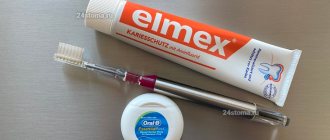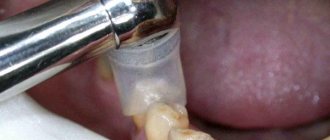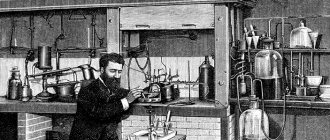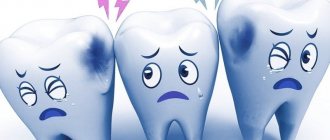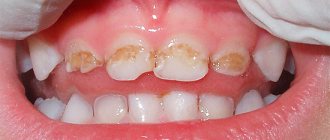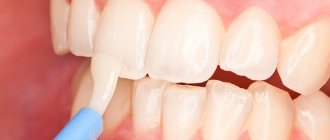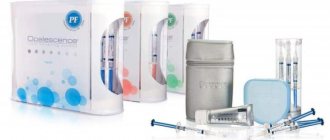Causes Types of prevention Hygiene Treatment in the stain stage How to avoid?
Caries is damage to hard dental tissues with the formation of cavity defects. First, the enamel is destroyed, then areas of dentin, pulp, periosteum and bone. It is the most common dental disease in the world and the leading cause of tooth loss. Comprehensive prevention of dental caries increases the resistance of the enamel layer to various cariogenic factors and prevents destruction of tooth structures.
Oral hygiene
It is necessary to regularly, at least twice a day, thoroughly (each time for at least five minutes) brush your teeth. When brushing your teeth, the brush head should make vertical (from the gums to the teeth), horizontal and circular movements. It is imperative to remove plaque from the tongue, and use dental floss to clean the interdental areas. For effective dental cleaning from the point of view of prevention, a correct, qualified selection of toothpaste is necessary, taking into account the individual characteristics and pathologies of the patient.
FLUOREPREVENTION OF CARIES Zhurbenko V.A.
Text of a scientific article
The principle approach to the prevention of dental caries is determined from the etiology and pathogenesis of this process. Many etiological factors take part in the occurrence of caries, which are divided into general and local. Local factors include: dental plaque and plaque, a violation of the composition and properties of oral fluid, which is an indicator of the condition of the body as a whole, carbohydrate sticky food residues in the oral cavity, resistance of dental tissues due to the full structure and chemical composition of hard dental tissues, deviations in the biochemical the composition of the hard tissues of the tooth and the defective structure of the dental tissues, the condition of the dental pulp, the condition of the dental system during the period of formation, development and eruption of permanent teeth. Common factors include: poor diet and drinking water, somatic diseases, changes in the functional state of organs and systems during the formation and maturation of dental tissues, extreme effects on the body, heredity that determines the usefulness of the structure and chemical composition of dental tissues, unfavorable genetic code. Knowledge of the causes and development of the disease is a necessary condition for the implementation of preventive measures. An epidemiological survey of the world's population showed that dental caries and periodontal disease are the most common diseases in the world, which manifest themselves in early childhood. The prevalence of dental caries in different regions of Russia ranges from 60 to 98%, and the intensity of dental caries according to the WHO classification ranges from very low to very high. Prevention of the occurrence of the carious process can be achieved by acting in two directions: increasing the resistance of enamel to the action of acid and/or reducing the cariogenic situation in the oral cavity. An increase in enamel resistance due to changes in its structure is achieved when fluorides enter the body. In addition, local exposure to fluoride directly on the tooth surface (solutions, toothpaste) also prevents the development of caries. The cariogenic situation in the oral cavity is undoubtedly influenced by two factors - microorganisms and carbohydrates. Based on this, strategic directions are obvious, which, in turn, determine the tactics of carrying out preventive measures. The optimal condition for successful prevention of dental caries is the introduction of a system of public and individual measures. Long-term clinical observations conducted in a number of countries have shown the effectiveness of fluoridation of drinking water (optimal concentration 1 ppm) in the prevention of caries. It is important to note that the effect is observed if the drinking water contains insufficient fluoride. Systemic methods of caries prevention also include fluoridation of salt and milk. Observations in a number of countries show that consumption of fluoridated milk from early childhood has a pronounced anti-caries effect. When choosing a systemic method of introducing fluoride into the body, it is necessary to have clear indications, the main of which are: • high incidence of dental caries among the population • low fluoride content in drinking water (less than half the optimal dose for each climatic zone) • lack of additional sources of systemic fluoride administration Despite Despite the high efficiency of systemic methods of fluoride administration, in many regions they cannot be implemented due to technological or economic reasons, so there is a need to use local methods to prevent dental caries. Fluoride-containing products for topical use include toothpastes, varnishes, rinses, solutions and gels for application, sealants and filling materials that gradually release fluoride. The use of fluoride in the form of drops or tablets can also be recommended as one of the possible ways of introducing fluoride into the body. Sodium fluoride tablets contain 2 mg of fluoride. Based on pure fluoride ion, each tablet contains 0.85 mg of fluoride. The use of sodium fluoride tablets can begin at 2 years of age and continue until 14-15 years of age. The number of tablets used will depend on the fluoride content in the water in a particular area and on the age of the child. However, the need for daily administration of the drug and dosage control significantly reduce the possibility of using this method. Contraindications to the prescription of tablets: 1) fluoride content in the environment is more than 50% optimal 2) any other methods of taking fluoride orally. Fluoride is also used in the form of drops - the drug “Vita-fluorine”. It is most effective to start taking fluoride with vitamins no later than 2 years after the birth of the child. “Vita-fluorine” is a light yellow liquid with a complex of vitamins A, C and D and sodium fluoride. 1 ml of the drug contains sodium fluoride 0.22 mg. It is used orally during or after meals for a month at intervals of 2-4 weeks every 3 months in areas where the fluoride content in drinking water is minimal. For children from 1 year to 6 years, the drug is prescribed ½ tsp. 1 per day; from 7 to 14 years - 1 tsp, 1 time per day for a month. After a 2-week break, the course is repeated. 4-6 courses of prevention are carried out per year. Fluoride-containing toothpastes are an effective means of prevention. It should be borne in mind that oral hygiene is an effective measure in itself, and its combination with the application of fluoride to the surface of the enamel has an active effect on reducing morbidity. Numerous observations indicate that to achieve a pronounced anti-caries effect, it is sufficient to apply small doses of fluoride to the tooth surface. It is important to do this systematically. Fluoride-containing pastes are also used in pediatric practice. But due to the fact that small children often swallow the toothpaste when cleaning, it is recommended to limit its use to those under 6 years of age. In this case, the amount of paste applied to the brush should not exceed the size of a pea. One of the most common means of local prevention of dental caries are varnishes, which are used to prolong the period of exposure to fluorides on the enamel. They form a film adjacent to the enamel that remains on the teeth for several hours, and in fissures, crevices and microspaces for several days and even weeks. Fluoride-containing varnishes are used 2 times a year, but in groups with an increased risk of caries - 4 times a year. Rinsing with fluoride solutions is carried out for 1-3 minutes, avoiding swallowing the liquid. After this procedure, be sure to rinse your mouth with clean water. It is not advisable to use this method for small children 2-4 years old. Rinses begin to be used when children erupt their first permanent teeth. This method of prevention does not require significant investment of time and material resources and at the same time is quite effective. In addition, fluoride-containing gels are used, which, in case of high caries susceptibility, are recommended to be used 4 times a year. The constancy of the enamel composition is ensured by the dynamic balance between the processes of demineralization and remineralization. If this balance is disturbed, either remineralization or demineralization will predominate, resulting in caries. By carrying out fluoride prophylaxis, it is possible to achieve a shift in the balance towards remineralization. Fluoride increases the acid resistance of enamel, which is very important in the presence of carious lesions. It has now been established that the effective anti-caries effect of fluoride is manifested even at low concentrations in application solutions or toothpaste. It is important to carry out these activities systematically and combine them with careful oral care.
Preventive examinations with a dentist
Like any disease, caries is better, easier and cheaper to treat at the very initial stage. The initial stages of caries cannot always be diagnosed by a non-specialist: for example, white (or chalky) spots, which indicate the beginning of the carious process, are not always clearly visible, may be in places difficult to see, and may be covered with a layer of plaque. Regular preventive examination by a dentist, which is recommended once every six months, will help you begin timely treatment and get rid of unpleasant, often painful and expensive procedures in the future, and will help you maintain healthy teeth for a long time.
How to avoid caries?
Depending on the depth of damage to hard tissues, there are 3 stages of caries - initial (spot stage), medium, deep. The rate of destruction of dental structures varies. In adults, the disease is predominantly sluggish and chronic. Children are more often diagnosed with an acute form of the disease with rapid destruction of dental structures. Inattention to the condition of teeth leads to progression of the disease. A carious lesion from the spot stage very quickly passes into the middle form, when dentin is destroyed and a visually noticeable defect is formed - a carious cavity.
How to avoid caries? Simple methods of primary prevention will help with this, most relevant when there is no visible damage to dental tissues.
Cost of treatment
| Inspection, general recommendations | For free |
| Anesthesia | |
| Appliqué | 200 |
| Injection | 550 |
| X-ray diagnostics (Visiograph “Satelek” Germany) | |
| Dental image without printing on a printer | 300 |
| Panoramic shot | 1000 |
| Dental filling (1-2 surfaces) | |
| Light-curing filling “Charisma” (Germany) | 2800 |
| Light-curing filling “Filtek” (USA) | 3970 |
| Restoration and cosmetic restoration of teeth (3 or more surfaces) | |
| Light-curing filling “Charisma” (Germany) | 3160 |
| Light-curing filling “Filtek” (USA) | 4260 |
| Veneering of anterior teeth | 6550 |
Payment by installments / Tax deduction
all prices
Types of prevention
Preventive measures are divided into primary and secondary. Primary prevention of caries is measures taken to prevent the disease, eliminate all provoking factors and causes of its development. It can be endogenous (general) and exogenous (local). The goal of the secondary set of preventive measures is to diagnose the disease at an early stage and prevent relapse.
Exogenous methods
Exogenous prevention of caries development includes methods that increase the resistance of the enamel layer to various cariogenic factors:
- Thorough
oral hygiene - Fluoridation
- the use of pastes, gels, solutions containing fluorine, calcium, phosphorus. Applications, physiotherapeutic procedures with remineralizing, fluoride compounds. Toothpaste for the prevention of caries, in addition to hygienic cleaning, provides additional mineralization of the enamel, increasing its protection, reducing the risk of disease. - Regular prof.
examinations - even in the absence of visible signs of carious lesions, you need to undergo a dental examination twice a year. This will help detect the problem at an early stage and quickly eliminate it without resorting to complex treatment or drastic measures. - Professional hygiene
– removal of dental plaque (plaque, stone) in a dental office. - Sealing fissures
with polymer compounds.
Molars and premolars of both jaws are more susceptible to carious lesions, with the lesion predominantly localized on the chewing surface (in fissures, blind foramina, folds). Obturation (sealing) of fissures and other anatomical recesses of the tooth with adhesive materials creates a physical barrier that prevents the penetration of pathogenic microorganisms and organic acids that destroy dental structures into the retention areas of the enamel. The method is aimed at preventing caries of temporary and permanent teeth. The procedure is painless, the effect lasts 3-5 years
.
Endogenous methods
Endogenous prevention of caries in adults can be medicinal (medicinal) and non-medicinal:
- Non-drug measures
involve dietary correction and a healthy lifestyle. Dental health is harmed by smoking, constant consumption of sweets, baked goods, and alcohol. It is recommended to give up bad habits and replace sweets and simple carbohydrates with berries and fruits. The diet should be balanced in the content of proteins, fats, carbohydrates, vitamins, essential minerals, and trace elements. - Drug prevention
includes taking fluoride-containing drugs, vitamin complexes, and nutritional supplements in age-specific dosages. The dentist selects medications for the prevention of caries individually, based on the condition of the teeth and general health.
Comprehensive prevention of dental caries includes a balanced diet, careful hygiene, and regular dental examinations. Even if a person brushes his teeth diligently, but abuses smoking or cannot go a day without sweets, he creates favorable conditions for the proliferation of cariogenic bacteria. Dental health needs to be taken care of as a whole. Can tooth decay be cured with toothpaste? No! But it is necessary to use it to prevent disease.
Products for the prevention of dental caries
Toothpaste against caries, or anti-caries, helps strengthen mineral dental tissues and prevents the formation of plaque due to the fluorine, phosphorus and calcium compounds introduced into the composition. The anti-carious effect of toothpastes is explained by the fact that topically applied fluorides increase the resistance of enamel to adverse effects. Penetrating into the enamel structure, fluorine creates a more durable fluorapatite system, fixes phosphorus-calcium compounds in hard dental tissues, and also suppresses the growth of soft plaque microflora. Anti-caries paste is most active during the period of enamel maturation, and later its effectiveness decreases significantly. Therefore, it is most reasonable to use anti-caries toothpastes in childhood to prevent caries in children.
Unlike toothpaste, a toothbrush can significantly improve or, if chosen incorrectly, worsen your oral health. For example, regular manual brushes with stiff bristles are not suitable for people with problem gums. Such brushing will only increase the colony of harmful bacteria and increase gum bleeding. The same can be said about electric toothbrushes, which also drive plaque under the gums, which leads to a serious inflammatory process. Today, the most effective way to prevent caries is to purchase a brush with ultrasound, which not only gets rid of plaque, but also destroys harmful microorganisms.
How to brush your teeth correctly?
It is impossible to thoroughly clean the entire surface of the teeth if the movements are directed only up and down or to the sides. You will also need to make diagonal or circular movements. It is desirable that the long bristles pick up plaque from under the gums. It is recommended to hold the brush at an angle of 45°C.
But all these rules have to be broken if brushing leads to bleeding gums. For those who have this predisposition, it is advisable to spend more time rinsing the mouth and use the brush as carefully as possible. Rinse aids must be antibacterial.
In general, it can be noted that in addition to good and constant oral care, it is important to see a dentist purely for preventive purposes, as well as for professional procedures that help maintain dental health.
Primary or endogenous prevention of caries
Proper nutrition is important in preventing tooth decay. This is not only about giving up chocolate and cakes, but also soda and concentrated juices. You should not eat sour apples, as they disrupt the acidity of saliva. It is better to replace them with hard, raw carrots, which clean your teeth almost better than a good specialized paste. It wouldn’t be a bad idea to nibble on Japanese horseradish – wasabi – from time to time. Japanese scientists have found that it blocks the growth of carious microbes.
Paradoxically, kissing is a great way to defeat tooth decay. When we kiss, the gums are massaged and salivation becomes more intense, and along with it, the acid-base balance is evened out.
If you have a tendency to develop caries, it makes sense to consult a specialist for recommendations on taking vitamins. Russian scientists have found that the demineralization of enamel is affected by a deficiency of vitamin C. During the experiment, it was found that those who were attacked by caries had a decrease in its content in the body several months before. In addition, vitamin D also increases the resistance of teeth to caries, since calcium is easily absorbed with it. Don't forget about such a useful element as fluorine. It has a pronounced anti-caries effect.
Causes of dental disease
There are many reasons why tooth enamel is destroyed. The main thing is damage by microorganisms that develop in the human mouth. As a result of their activity, bacteria produce organic acids that dissolve hard tissues. Therefore, the main measure to prevent dental caries is careful oral hygiene.
Factors that cause the development of the disease also include the following:
- Excessive viscosity of saliva. If saliva is viscous, plaque from the tooth surface, where bacteria develop, is not naturally removed. Therefore, it must be removed during professional cleaning by the dentist.
- Crowded bite, in which it is important to thoroughly clean the space between the teeth.
- Poor or complete lack of oral hygiene.
- Stone formation, which also causes periodontal problems.
- Eating foods high in carbohydrates. Therefore, it is better to consume sweets in moderation.
- Exposure to harmful occupational factors. Carious lesions often develop in people working in hazardous industries.
- Injuries to the coronal part that cause the destruction process. The enamel is damaged, so it is more susceptible to negative effects.
Dental disease can be caused by a hereditary predisposition.
Most often, carious cavities develop on contact surfaces, in the blind pits of the incisors, in the cervical region, and on fissures. To prevent the development of the disease, various methods of caries prevention are used.

